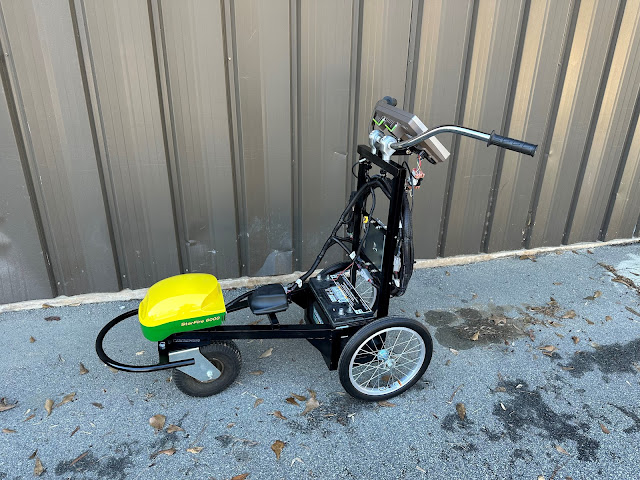LevelUPTM Roller Mounts are a product of one man's frustrations while attempting to accurately parallel the front rollers on John Deere QA5 cutting units, and also his anguish when one of the factory brackets failed in a spectacular way, causing turf damage and embarrassment.
The back story: My assistants and I have been working with John Deere QA5 cutting units for many years, and we had all grown to dread adjusting the front roller eccentrics, a task that I felt took too long and needed to be done too often. The excessive play in the factory roller bracket assembly combined with the inherent inaccuracy of the design was the source of the frustration. Back in 2019 we had one of our front roller brackets come loose at the eccentric adjuster on a greens mower during use. Of course it happened on the (huge) main putting green, the day before our member-guest tournament. The operator said he did feel the mower pulling some, as the bedknife was digging into the canopy - for several passes across the green (it was dark, of course).
This was the last straw for me. That day I vowed to fix those blasted mounts once and for all, and after a two year development period which involved learning new (to me) manual machining methods, TIG welding, 3D CAD modeling, and dealing with a top tier CNC machining job shop, I did it! As of this writing; we have been using LevelUPTM Roller Mounts on all of our greens cutting units at the Atlanta Athletic Club for over a year with zero issues.
After much prodding (thanks Larry and Mark) and contemplation I have decided to bring LevelUPTM Roller Mounts to market. LevelUPTM Roller Mounts are now available through Turf Addict here! The end product has exceeded my expectations, and I have been getting great reviews from all who have tried them to-date.
I want to share and document the development of LevelUPTM Roller Mounts here, and explain the benefits of their use.
This was the starting point:
The JD design has three main components; the cast steel vertical and horizontal brackets, and the machined eccentric bushing which controls the position of the horizontal bracket relative to the vertical bracket.
The three parts of the roller bracket are held together with one 10mm hex head bolt which threads into the horizontal bracket and sandwiches the vertical bracket between the horizontal bracket and the eccentric. It is interesting to note that the outer diameter of the eccentric is machined to a slight taper, so that there is an interference fit between the eccentric and the vertical bracket when the hex head bolt is tightened. I suspect this was done to save money on finish machining the cast parts. Because the parts are left as cast, there needs to be a generous clearance between the two brackets, and this clearance leads to the frustrating amount of play, or slop, when performing adjustments. The clearance also allows the horizontal bracket to move slightly when the assembly experiences the shock and vibrations of normal use. When the horizontal bracket moves, the hex head bolt threaded into it can loosen, leading to Equipment Manager meltdown...
The vertical bracket has numbers cast in which are used to index it's position relative to the side frame for setting height of cut (HOC) ranges in 5mm increments. The back side of the vertical bracket has 5mm teeth which fit together with corresponding teeth cast into the cutting unit side plate. The roller shaft is retained in the horizontal bracket with a 6mm bolt and lock nut. The whole assembly is clamped to the side frame with one 10mm carriage bolt and lock nut through the slot in the bracket.
And after several steps, here is my solution:
My design uses a solid "L" shaped mount with a saddle on the bottom to receive an eccentric split bushing which is retained from the bottom with a two-bolt saddle clamp. When the clamp is tightened, the tight fitting split bushing is compressed around the roller shaft, creating a solid load path from the roller shaft through the part, with no joints to flex and virtually no possibility of the roller moving - and HOC changing - unintentionally. The mounts have the 5mm tooth pattern and index numbers machined in and locate the roller in the factory position. Each mount provides +/- .030" of adjustment and is fast and easy to dial in. All of the part features are CNC machined from steel bar stock, and then the parts are clear zinc plated for corrosion resistance.
Installing and using LevelUPTM Roller Mounts is super easy, and frankly kind of boring after a while when you realize roller adjustments are seldom needed after the initial setup. But if you ever do need to adjust a LevelUPTM Roller Mount, it will be quick, accurate, and easy to do.
Thanks to all who have purchased LevelUPTM Roller Mounts! I hope you love them as much as I do!
Thanks to Mike Rollins for shooting the video below:





















